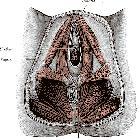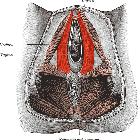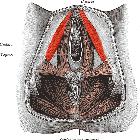Levator ani muscle










The levator ani muscle, also known as the muscular pelvic diaphragm, is the musculotendinous sheet that forms the majority of the pelvic floor, supports the pelvic viscera, and aids in urinary and fecal evacuation as well as maintaining continence.
Gross anatomy
The levator ani has three main components, each of which is paired :
- pubococcygeus (pubovisceral) muscle
- subparts: puboperineal, pubovaginal, puboanal muscles
- iliococcygeus muscle
- puborectalis muscle
The pubococcygeus muscle runs from the inner surface of the pubis and obturator fascia with fibers fusing medially at the perineal body and musculature of the prostate/vagina.
The iliococcygeus muscle attaches to the inner tip of the coccyx posteriorly. Posterolaterally, it attaches to the ischial spine and along the tendinous arch of the obturator fascia (a.k.a. the tendinous arch of the levator ani), which is a thickened band of the fascia covering the inner aspect of the obturator internus muscle. Anteriorly and medially, it fuses with the pubococcygeus.
Puborectalis takes attachment from the pelvic surfaces of both ischiopubic rami, anterolaterally. It passes posterior to the rectum to form a muscular sling.
The coccygeus muscle (also known as ischiococcygeus) is not formally a part of the levator ani muscle . It is a triangular muscle with its base attaching to the lateral aspect of the inferior sacrum and coccyx and apex attached to the ischial spine. It flexes the coccyx anteriorly and partially fuses with the sacrospinous ligament.
Arterial supply
- the three muscles are supplied by the inferior rectal and internal pudendal arteries
Innervation
- pelvic surface: branches of S3, S4
- perineal surface: branches of the pudendal nerve
Variant anatomy
- thinning or aplasia of one or both sides is common (~50%)
Siehe auch:
- Musculus bulbospongiosus
- Musculus ischiocavernosus
- Musculus transversus perinei profundus
- Musculus transversus perinei superficialis
- Beckenbodenmuskulatur
- Musculus coccygeus
- Diaphragma pelvis
- Musculus levator ani
- Fossa ischiorectalis
- Musculus sphincter ani externus
- Schwellkörper- und Schließmuskelschicht
- Diaphragma urogenitale
und weiter:

 Assoziationen und Differentialdiagnosen zu Levator ani muscles:
Assoziationen und Differentialdiagnosen zu Levator ani muscles:




